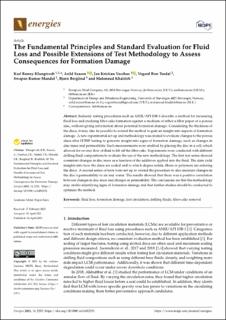| dc.contributor.author | Klungtvedt, Karl Ronny | |
| dc.contributor.author | Saasen, Arild | |
| dc.contributor.author | Vasshus, Jan Kristian | |
| dc.contributor.author | Trodal, Vegard Bror | |
| dc.contributor.author | Mandal, Swapan Kumar | |
| dc.contributor.author | Berglind, Bjørn | |
| dc.contributor.author | Khalifeh, Mahmoud | |
| dc.date.accessioned | 2021-08-04T11:44:09Z | |
| dc.date.available | 2021-08-04T11:44:09Z | |
| dc.date.created | 2021-07-12T09:49:25Z | |
| dc.date.issued | 2021-04 | |
| dc.identifier.citation | Klungtvedt, K. R., Saasen, A., Vasshus, J. K., et al. (2021). The Fundamental Principles and Standard Evaluation for Fluid Loss and Possible Extensions of Test Methodology to Assess Consequences for Formation Damage. Energies, 14(8), 2252 | en_US |
| dc.identifier.issn | 1996-1073 | |
| dc.identifier.uri | https://hdl.handle.net/11250/2766211 | |
| dc.description.abstract | Industry testing procedures such as ANSI/API 13B-1 describe a method for measuring fluid loss and studying filter-cake formation against a medium of either a filter paper or a porous disc, without giving information about potential formation damage. Considering the thickness of the discs, it may also be possible to extend the method to gain an insight into aspects of formation damage. A new experimental set-up and methodology was created to evaluate changes to the porous discs after HTHP testing to generate insight into signs of formation damage, such as changes in disc mass and permeability. Such measurements were enabled by placing the disc in a cell, which allowed for reverse flow of fluid to lift off the filter-cake. Experiments were conducted with different drilling fluid compositions to evaluate the use of the new methodology. The first test series showed consistent changes in disc mass as a function of the additives applied into the fluid. The data yield insights into how the discs are sealed and to which degree solids, fibers or polymers are entering the discs. A second series of tests were set up to extend the procedure to also measure changes in the disc’s permeability to air and water. The results showed that there was a positive correlation between changes in disc mass and changes in permeability. The conclusions are that the methodology may enable identifying signs of formation damage and that further studies should be conducted to optimize the method. | en_US |
| dc.language.iso | eng | en_US |
| dc.publisher | MDPI | en_US |
| dc.rights | Navngivelse 4.0 Internasjonal | * |
| dc.rights.uri | http://creativecommons.org/licenses/by/4.0/deed.no | * |
| dc.subject | petroleumsteknologi | en_US |
| dc.subject | borevæske | en_US |
| dc.title | The Fundamental Principles and Standard Evaluation for Fluid Loss and Possible Extensions of Test Methodology to Assess Consequences for Formation Damage | en_US |
| dc.type | Peer reviewed | en_US |
| dc.type | Journal article | en_US |
| dc.description.version | publishedVersion | en_US |
| dc.rights.holder | Copyright: © 2021 by the authors. | en_US |
| dc.subject.nsi | VDP::Teknologi: 500::Berg‑ og petroleumsfag: 510::Petroleumsteknologi: 512 | en_US |
| dc.source.volume | 14 | en_US |
| dc.source.journal | Energies | en_US |
| dc.source.issue | 8 | en_US |
| dc.identifier.doi | 10.3390/en14082252 | |
| dc.identifier.cristin | 1921410 | |
| dc.source.articlenumber | 2252 | en_US |
| cristin.ispublished | true | |
| cristin.fulltext | original | |
| cristin.qualitycode | 1 | |

